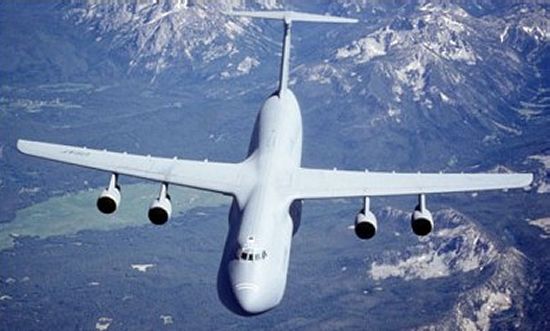|
||||||||||
|
|
||||||||||
|
||||||||||
|
|
||||||||||
 - -
|
|

|
Lockheed C-5 Galaxy Heavy Transport |
|
DESCRIPTION:
Needing an extremely large strategic transport, the Air Force selected Lockheed to develop a complement to its C-141. The resulting C-5 Galaxy was, for a time, the largest aircraft in the world. The design utilizes loading doors at both the front and rear of the fuselage to provide the aircraft with an unobstructed cargo deck 121 ft long and 19 ft wide. The C-5 is also equipped with high-lift slats and flaps to reduce takeoff length, air-refueling capability for unlimited range, advanced radar equipment, and 28-wheel landing gear able to operate from unpaved surfaces. Though the aircraft soon proved invaluable for long-distance heavy transport, the C-5 suffered from significant structural fatigue early in its lifetime. These structural cracks limited the planes to only 1/5th of their maximum payload capacity. To restore full capability and extend service life, the US Air Force was forced to have all 77 C-5A aircraft then in service re-built with a new wing. Still more improvements in reliability were introduced in 50 C-5B aircraft that featured newer engines and avionics. The C-5 continues to serve as the primary heavy transport for the USAF alongside the C-17 Globemaster III. However, budget planners have long battled over investing in modernizing the aging C-5 fleet or instead purchasing more C-17 transports. The Air Force has so far decided to give all 111 remaining C-5 aircraft an avionics upgrade to replace outdated electronics systems, but only 49 of these will also receive a costly engine replacement. The modernized planes are known as the C-5M.
Data below for C-5A |
|
| HISTORY: | |
| First Flight |
(C-5A) 30 June 1968 (C-5 AMP) 21 December 2002 (C-5M) 19 June 2006 |
|
Service Entry
|
(C-5A) 17 December 1969 (C-5B) 1980 |
|
CREW:
|
seven: pilot, co-pilot, two flight engineers, three loadmasters
|
| PASSENGERS: |
345 troops
|
|
ESTIMATED COST:
|
(C-5A) $152.8 million [1998$] (C-5B) $179 million [1998$] |
| AIRFOIL SECTIONS: | |
| Wing Root | NACA 0013-44 mod |
| Wing Tip |
Hybrid NACA 11%
|
| DIMENSIONS: | |
| Length | 247.83 ft (75.54 m) |
| Wingspan | 222.71 ft (67.88 m) |
| Height | 65.13 ft (19.85 m) |
| Wing Area | 6,200 ft² (576.0 m²) |
|
Canard Area
|
not applicable
|
| WEIGHTS: | |
| Empty | 337,935 lb (153,285 kg) |
| Normal Takeoff | 769,000 lb (348,815 kg) [peacetime limit] |
| Max Takeoff | 840,000 lb (381,015 kg) [wartime maximum] |
| Fuel Capacity | 51,150 US gal (193,620 L) |
|
Max Payload
|
261,000 lb (118,385 kg)
|
| PROPULSION: | |
| Powerplant |
(C-5A/B) four General Electric TF-39-1 turbofans (C-5M) four General Electric CF6-80C2 turbofans |
|
Thrust
|
(C-5A/B) 164,000 lb (730 kN) (C-5M) 216,000 lb (961 kN) |
| PERFORMANCE: | |
| Max Level Speed |
at altitude: 570 mph (920 km/h) at 25,000 ft (7,920 m), Mach 0.82 at sea level: unknown cruise speed: 520 mph (835 km/h) at 30,000 ft (9,145 m), Mach 0.77 |
| Initial Climb Rate | 1,800 ft (550 m) / min |
| Service Ceiling | 34,000 ft (10,360 m) |
| Range |
typical: 5,680 nm (10,505 km) ferry: 6,960 nm (12,875 km) [unrefueled] |
| g-Limits |
unknown
|
| ARMAMENT: | |
| Gun | none |
| Stations | none |
| Air-to-Air Missile | none |
| Air-to-Surface Missile | none |
| Bomb | none |
| Other |
none
|
| KNOWN VARIANTS: | |
| C-5A | First production model; 81 built |
| C-5B | Improved transport with ugraded engines, improved avionics, and stronger structure to increase fatigue life; 50 built |
| C-5C | Modified variant with an enlarged cargo compartment for carrying special large payloads like satellites; 2 built and operated by the USAF on behalf of NASA |
| C-5 AMP | Avionics Modernization Program to install a digital architecture backbone, add new cockpit displays, and replace obsolete communication and navigation systems; 111 to be converted (62 C-5A, 47 C-5B, 2 C-5C) |
| C-5 RERP | Reliability Enhancement and Re-engining Program to replace the TF39 engines with CF6-80C2 turbofans as well as make other upgrades to the airframe, landing gear, cockpit, and other systems; 49 to be converted (47 C-5B, 2 C-5C) |
| C-5M Super Galaxy |
New designation for C-5 models completing the AMP and RERP upgrades
|
| KNOWN COMBAT RECORD: |
Vietnam War (USAF, 1970-1972) Yom Kippur War (USAF, 1973) Iraq - Operation Desert Storm (USAF, 1991) Kosovo - Operation Allied Force (USAF, 1999) Afghanistan - Operation Enduring Freedom (USAF, 2001-present) Iraq - Operation Iraqi Freedom (USAF, 2003-present) |
| KNOWN OPERATORS: |
United States (US Air Force)
|
|
3-VIEW SCHEMATIC:

|
|
SOURCES:
|
|


|
Aircraft | Design | Ask Us | Shop | Search |

|
|
| About Us | Contact Us | Copyright © 1997- | |||
|
|
|||